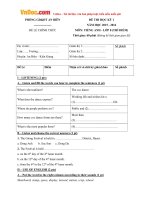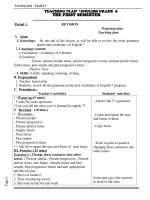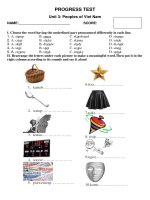tiếng anh lớp 8 thí điểm Unit 7
Bạn đang xem bản rút gọn của tài liệu. Xem và tải ngay bản đầy đủ của tài liệu tại đây (103.19 KB, 8 trang )
Unit 7: pollution
A. Listen and read
I.
Đọc & cung cấp lại từ mới
Pollute : (v) ô nhiễm
Pollution: (n) sự ô nhiễm
Dump : (v) vứt, bỏ
Poison : (n,v) chất độc, làm nhiễm độc
Aquatic : (adj) dưới nước
Aquatic animal : động vật sống dưới nước
Sneeze : (v) hắt hơi
Illustrate : (v) minh họa
II.
Dịch
B. Vocabulary
I.
Complete the table with appropriate verbs, nouns, and adjectives.
Verb
Noun
Adjective
To poison
…
Poisonous
…
Contamination
Contaminated
Contaminant
To pollute
Pollution
….
….
II.
To die
…
dead
To damage
Damage
….
Complete the sentences, using the correct form of the words in
brackets.
1. Scientists say that exhaust fumes are …………….. our city. ( poison)
2. Many seabirds were ………..because of the oil spill. (die)
3. Waste from households will gradually ………………the lake.
( contamination)
4. Do you know what …………cause air pollution? (pollute)
5. The acid rain has cause ……………..to the trees in this area.
( damage)
III.
Nhận biết Cause và effect
Cause:
Because/ since + clause
Due to/ because of + sth ( cụm danh từ, danh từ )
Effect:
So + clause
To cause sth / to lead sth/ to results in sth
To make sb/ sth do sth
Bài tập
1. Ships spill oil in oceans and rivers. Many aquatic animals and
plants die.
( lead to)
(because)
2. Noise pollution happens. There is a change in animals’ living
pattern.
(because of)
(so)
3. Acid rain is dangerous. Trees’ leaves are damaged.
( make)
( due to)
(so)
(cause)
4. We can’t see the stars at night. There is too much light pollution.
(since)
(So)
(lead to)
(due to)
5. Households dump waste into the river. It is polluted.
(so)
(because of)
(lead to)
(since)
Làm bài ba trang 4 sách bài tập
C. Trọng âm
- Quy tắc đánh trọng âm với các từ kết thúc bằng đuôi “ic”
Đánh trọng âm vào âm trước nó
Vd: a’tomic
- Với các từ kết thúc bằng đuôi “al”
Trọng âm của từ sẽ không bị thay đổi
Vd: ‘music ‘musical
‘nation ‘national
- Note: nếu trong từ có cả đuôi “ic” và “al” “ical” thì trọng âm đánh
theo đuôi “ic” nghĩa là trọng âm sẽ rơi ở âm trước “ic”
E’conomy eco’nomic eco’nomical
Làm bài 5/ 9 sgk
D. Grammar
1) Câu điều kiện loại 1.
a. Khái niệm
Câu điều kiện loại I còn được gọi là câu điều kiện có thực ở hiện tại.
Điều kiện có thể xảy ra ở hiện tại hoặc tương lai.
b. Cấu trúc
If + S + V (hiện tại), S + will + V (nguyên mẫu)
If I have money, I will buy a new car.
c. Cách dùng
Ta dùng câu điều kiện loại I để đặt ra một điều kiện có thể thực hiện được
trong hiện tại và nêu kết quả có thể xảy ra. ( dk trong mde if có thể xảy
ra)
Note:
Câu điều kiện loại 0 : If+S+ V(ht), S+ V(htai)
Diễn tả một thói quen, một qui luật, một sự thật hiển nhiên
If we boil water, it vapors.
Diễn tả một đề nghị lịch sự
If + S + V(ht) …, mệnh lệnh thức trực tiếp
If you go to the Post Office, please mail this letter for me.
Thông thường dùng thì hiện tại đơn trong mệnh đê if của câu điều kiện loại
1, nhưng ta vẫn có thể dùng thì hiện tại tiếp diễn để diễn đạt sự tiếp diễn của
hành động và dùng thì hiện tại hoành thành để diễn đạt sự hoàn tất:
If the baby is sleeping, don’t make noise. (Nếu em bé đang ngủ, đừng làm
ồn.)
If you have finished your work, you can go home. (Nếu bạn làm xong thì
bạn có thể về)
If + S + should, + “mệnh lệnh thức”...: ví như: Diễn đạt một trường
hợp có thể xảy ra được nhưng rất khó. Trong một số trường hợp người ta bỏ
if đi và đảo should lên trên chủ ngữ.
If you should find any difficulty in using your computer, please call me this
number.
Should you find any difficulty in using your computer, please call me this
number.
d. Bài tập: put the verbs in brackets in to the correct form.
1) If we...........(to send) an invitation, our friends...........(to come) to our
party.
2) He...........(not/to understand) you if you (to whisper).
3) They...........(not/to survive) in the desert if they...........(not/to take) extra
water with them.
4) If you...........(to press) CTRL + s, you...........(to save) the file.
5) You...........(to cross) the Channel if you...........(to fly) from Paris to
London.
6) Fred...........(to answer) the phone if his wife (to have) a bath.
7) If Claire...........(to wear) this dress at the party, our guests...........(not/to
stay) any longer.
8) If I...........(to touch) this snake, my girlfriend...........(not/to scream).
9) She...........(to forget) to pick you up if you (not/to phone) her.
10) I...........(to remember) you if you...........(to give) me a photo.
2) Câu điều kiện loại 2
a) Khái niệm
Câu điều kiện không có thực ở hiện tại hoặc tương lai.
b) Công thức
If + S + V(qk), S+ would/could+ V(nt)
If he didn’t speak so quickly, you could understand him.
c) Cách dung
Dùng để diễn tả một hành động, sự việc không có thật hoặc không thể xảy ra ở
hiện tại hoặc tương lai.
Note:
Nếu ở mệnh đề If có động từ tobe thì be sẽ là were cho tất cả các ngôi I, He,
She, It. Tuy nhiên trong văn nói người ta vân dung was cho các ngôi he, she, it.
Ex: if I were you, I would come back home.
Câu dk có mk if I were you có thể được sử dụng như một lời khuyên hoặc đưa
ra một ý kiến.
Note: unless = if not
Trong câu có unless thì k có dạng phủ định
d) Bài tập
1) If we (have) ………. a yacht, we (sail) ………the seven seas.
2) If he (have) ………. more time, he (learn) ……….karate.
3) If they (tell) ………. their father, he (be) ………..very angry.
4) She (spend) ………. a year in the USA if it (be) ……….easier to get a
green card.
5) If I (live) ………. on a lonely island, I (run) ………. around naked all
day.
6) We (help) ………. you if we (know) ………..how.
7) My brother (buy) ………. a sports car if he (have) ………. the money.
8) If I (feel) ………. better, I (go) ……….to the cinema with you.
9) If you (go) ………. by bike more often, you (be / not) ………. so flabby.
10)
She (not / talk) ………. to you if she (be) ……… mad at you.
E. Reading
i.
Vocabulary
Groundwater: (n) Nước ngầm
Sewage: (n) Nước thải
Pesticide: (n) Thuốc trừ sâu
Insect: (n) côn trùng
Herbicide: (n) Thuốc trừ cỏ
Weed: (n) cỏ dại
Point source pollution: ô nhiễm có nguồn
Non-point source pollution: ô nhiễm không nguồn









